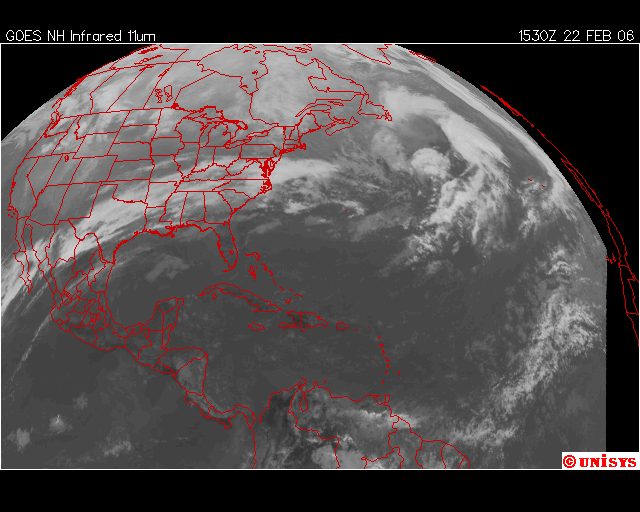 Copyright © Michael Richmond.
This work is licensed under a Creative Commons License.
Copyright © Michael Richmond.
This work is licensed under a Creative Commons License.
The orbit of a geosynchronous satellite
You've all seen satellite images of weather patterns:

Thanks to Unisys
In order to provide continuous coverage of one
section of the Earth -- such as the Eastern US --
a satellite must have a very special orbit:
it must have a period of (almost) exactly 24 hours.
If it does, then it will seem to hover directly
over one area on Earth.
How can we cause a satellite's orbit to have a
period of P = 24 hours? Hmmm.
Maybe we just need to find the right orbital radius R ....
- What is the speed v
of a geosynchronous satellite?
Your answer should have some factor of R in it ...
- What is the centripetal acceleration of
this satellite? Your answer should still have R in it ...
- What is the acceleration due to gravity for this satellite?
Again, your equation should have some factor of R.
- Solve for the orbital radius R
at which gravity provides
the required centripetal acceleration.
- How far above the surface of the Earth is this?
- Let's make a scale model of the Earth and some
satellites. I'll place a soccer ball at the front
of the classroom, to represent the Earth.
- How far away from the soccer ball should I
place a model of the ISS?
- How far away from the soccer ball should I
place a model of a geosynchronous satellite?
For more information
 Copyright © Michael Richmond.
This work is licensed under a Creative Commons License.
Copyright © Michael Richmond.
This work is licensed under a Creative Commons License.

 Copyright © Michael Richmond.
This work is licensed under a Creative Commons License.
Copyright © Michael Richmond.
This work is licensed under a Creative Commons License.
 Copyright © Michael Richmond.
This work is licensed under a Creative Commons License.
Copyright © Michael Richmond.
This work is licensed under a Creative Commons License.